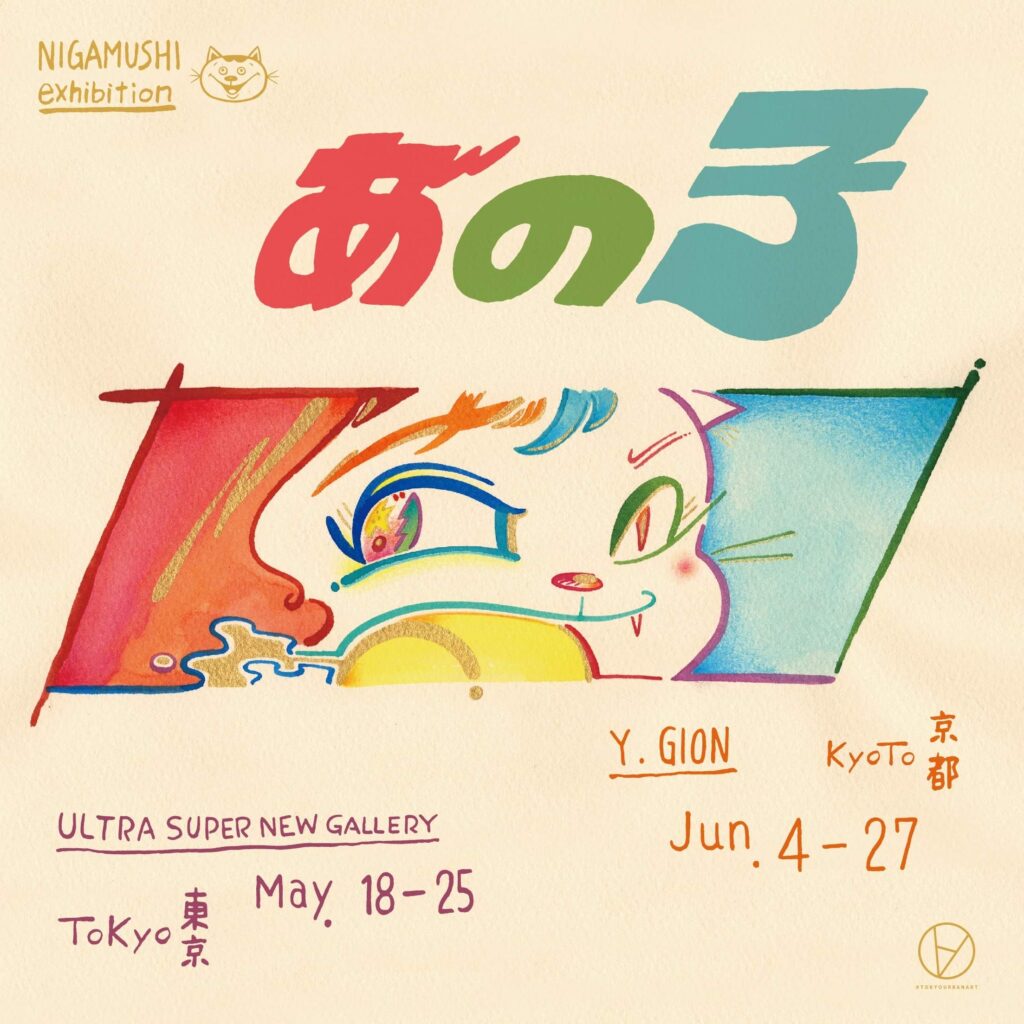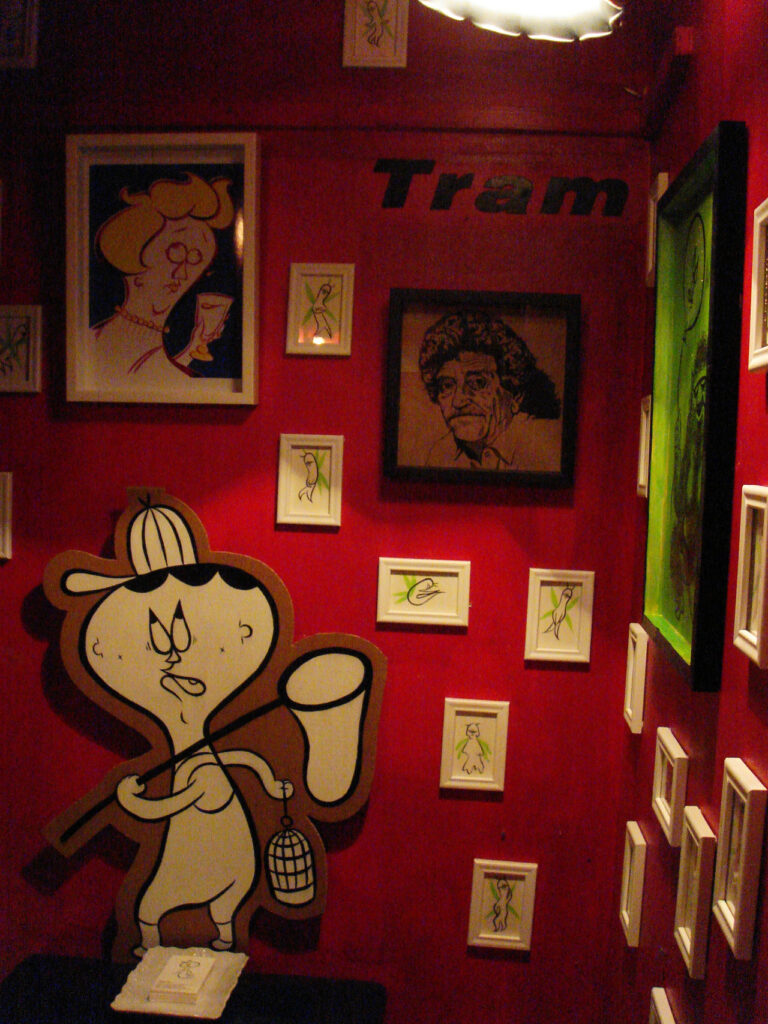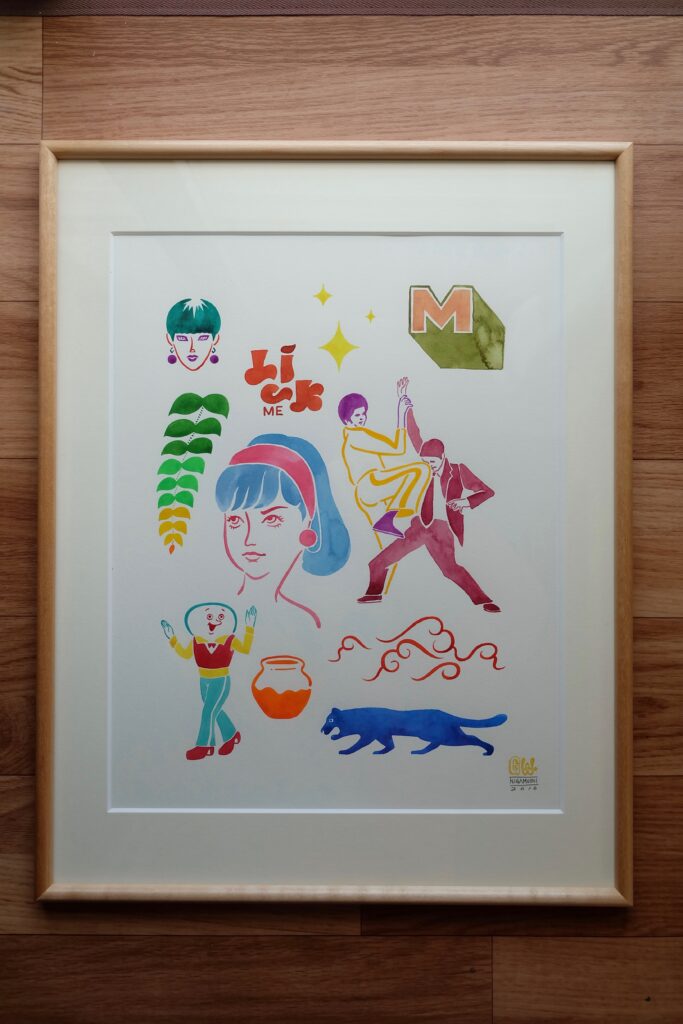- JAPANESE
- LANGUAGE
X
 THAT IS GOOD
THAT IS GOOD
This is the second issue of our project to introduce artists recommended by THAT IS GOOD in order to share Japanese contemporary art to the world!
This time, we would like to introduce you to Tsuyoshi Nigamushi, who is currently holding his solo exhibition “Anoko” at a gallery called ”y gion” in Higashiyama-ku, Kyoto from June 4 to June 27 2021.
He started his career as ” Tsuyoshi Nigamushi” in 2009, and it has been 12 years since then.
In my opinion, he is an artist with a contradictory style: loose and poppy, but also stylish and modern, with a sense of homage.


苦虫ツヨシ / Nigamushi
Painter, Art Director Having solo exhibitions or curating his own events not only in Japan but overseas,He is working in Visual Arts in multiple fields such as Character Design, Logo Design,Package Design, and creating his own original goods.
ーFirst, tell us about your backbone!
I’ve loved drawing since I was a child, and it’s already become a part of my life.
The elements that have shaped me are anime and manga. As for manga, I’d have to say Jump. For my generation, it’s Dragon Ball.
Also, my sister was a bit of an otaku, so I used to read Animage. I read things like “Legend of Heavenly Sphere Shurato”, “Future GPX Cyber Formula”, and “Slayers”. It’s not that I’m completely into it, but… lol
In that sense, I think my hobbies came out unconsciously in this exhibition lol
ーIt seems unimaginable when I look at your other works, but there is certainly a sense of that kind of backbone in ” Anoko”. On the other hand, you were also influenced by hip-hop, weren’t you?
Yes, I fell in love with the hip-hop culture in my teens.
Graffiti was one of them. I used to draw cartoons, but when I saw the magazine, I was like, “What! Who draws this stuff with spray paint? I was shocked.
That was the basis of my work.
ーThen, after graduating from high school, you moved to Tokyo and surprisingly entered a technical school to study craft design instead of graphic design.
At the time, I thought of drawing as a hobby, so I entered the Industrial Craft Design Department at Nippon Design College to become a designer.
At school, there are majors, aren’t there? But at the time, I wanted to do everything, and I thought that I could do anything here, relatively speaking.
I had always wanted to do three-dimensional work, so I did industrial design, craft design, ceramics, metalwork, glass, craft design, silver accessories, and furniture by myself.
ーAfter graduation, Mr. Nigamushi entered a construction management company as a part-time worker. He was confused by the world, which was completely different from the interior design industry he had thought of, but a change in the times led him to shift the direction of his work.
With the advent of Illustrator on the Mac, graphic design became something that even individuals could do. As a result, I started working in the design and printing industry.
However, I realized that I was not enthusiastic about graphic design, and I realized that if I could continue to draw pictures that I had always loved, I would be able to do so for a long time, so I started having solo exhibitions when I was 28.
ーSo that’s how you got to where you are today. That’s quite a big shift…!
Does your experience at the construction management company have any link to your current artwork?
When I was working for an interior decorator, I was able to take on various jobs such as interior design, space design, and printing… Then, sometimes I do solo exhibitions as I wish…. As a sole proprietor, I can put all my skills to work lol
Well, there are no restrictions on what I have to do as a painter or what I can’t do as a painter.
ーOkay. So all of your experiences have led to your ideas and work.
Yes. By the way, the first artist who influenced me was Philippe Starck, and when I saw his collection of works, I knew about the famous Asahi Breweries headquarters building, but I was surprised to see that he was also involved in product design, even though he was an architect. I remember how surprised I was.
Similarly, I have been very much influenced by people who are multi-talented. I like filmmakers who have a variety of story elements, and I find diversity in people like Robert Rodriguez and Quentin Tarantino.
Other people who have influenced me include Shinro Ohtake. It is amazing that he is able to handle such a large amount of work by himself. Also, Picasso, Taro Okamoto, Tadanori Yokoo… they all do things freely and honestly! I was influenced by them in some ways.
That’s why I draw what I want to draw, although I don’t have a clear reason for doing so.


Painted in a variety of styles.
ーIn the sense that they are people who input a lot of things and come up with their own unique worldview, everyone is consistent. But they are also not afraid of change, and even when they change, their own colors come out. I feel the same way about the appeal of Nigamushi Tsuyoshi’s work. By the way, where does he usually get your inspiration for your work?
I think it’s like anything else, it’s all about flow and story. I don’t suddenly start drawing pictures like Yayoi Kusama. In the end, it’s all about accumulation.
I keep on changing. I use different materials for painting. I feel that my work changes depending on the paper and materials that I am using at the time.
I’m able to draw with a variety of touches, so for example, when I draw a picture for work, it’s a touch that I normally wouldn’t try to draw, but then I realize that I can draw like this, and I often incorporate that into my work.
ーBy the way, you said “I can draw pictures like this,” but do you have any specific episodes?
The TRAFFIC series was originally born out of an illustration for English teaching materials at a junior high school I was working for, where the composition was something like a teacher handing out a print to a student….
The original illustration was very sober, but I decided to add a bit of humor to the same touch! That kind of thing. That’s how things sometimes come about.
On the other hand, there are opportunities to incorporate new touches into the work lol

ーMy personal impression is that the overall style of the paintings often uses faces as motifs, and I felt that they were modern, but also nostalgic and homage.
Basically, I guess I have always liked iconic things. I like designs, pictograms, old folk masks, Japanese masks… I am attracted to iconic things. That’s why I often draw close-ups of faces in my pictures. Sometimes I feel that if I put on a body, the beauty of the face is gone.
In addition, I like hip-hop, so I’m drawn to the sampling element of “I have an original story…”. In the TRAFFIC series, I purposely decided on a theme based on the original source material.


One of the charms of the work is that various characters can be seen in a single illustration
ーIndeed, that’s what he said, and it hit me. What I found interesting was that there were many elements that reminded me of the sampling technique of combining things that should not live together, such as loose characters and stylish people.
My blood type is AB, so it’s like an ambivlance. I don’t know if that has anything to do with it lol
Actually, there was a time when I wanted to be a chef when I was in junior high school, but when I watched the TV show “Iron Chef,” I wondered, “Why do they divide cuisine into Japanese, Western and Chinese genres?” Nowadays, creative cooking is common, but back then, it was normal to be separated.
Most people are inclined to one or the other, but in my case, I want to do both.
That’s why I like Hokusai. He tried his hand at Shunga, manga, and many other things, and when he was dying, he said, “If I had ten more years, I could have mastered it.
If I continue to paint like Hokusai, worrying and introducing new tastes, I think I can do it for the rest of my life!
Above is the summary of this article, focusing on the background of Tsuyushi Nigamishi as an artist.
The names of various artists have come up, from Philippe Starck to Robert Rodriguez to Hokusai. They are artists who have continued to change their mediums and styles, but at the same time, I think it’s characteristic that there are parts that make you think, “This is a style that is typical of ●●.
What I felt was that Mr. Nigamushi’s style is definitely the same, and even though each work has a different taste, there are parts that make you think, “That’s Mr. Nigamushi!” And I got the impression that he is a member of the lineage of his predecessors that I mentioned earlier!
The sense of color, the texture of the lines, and above all, the unshakeable atmosphere of the pieces give the impression of “Come on! Come to the Nigamushi World!”
In the next article, I would like to talk about “Anoko,” which is a new frontier among his works and also the title of his current solo exhibition, as well as the process of creating his works. Look forward to it!
TEXT : THAT IS GOOD editorial department, Koga